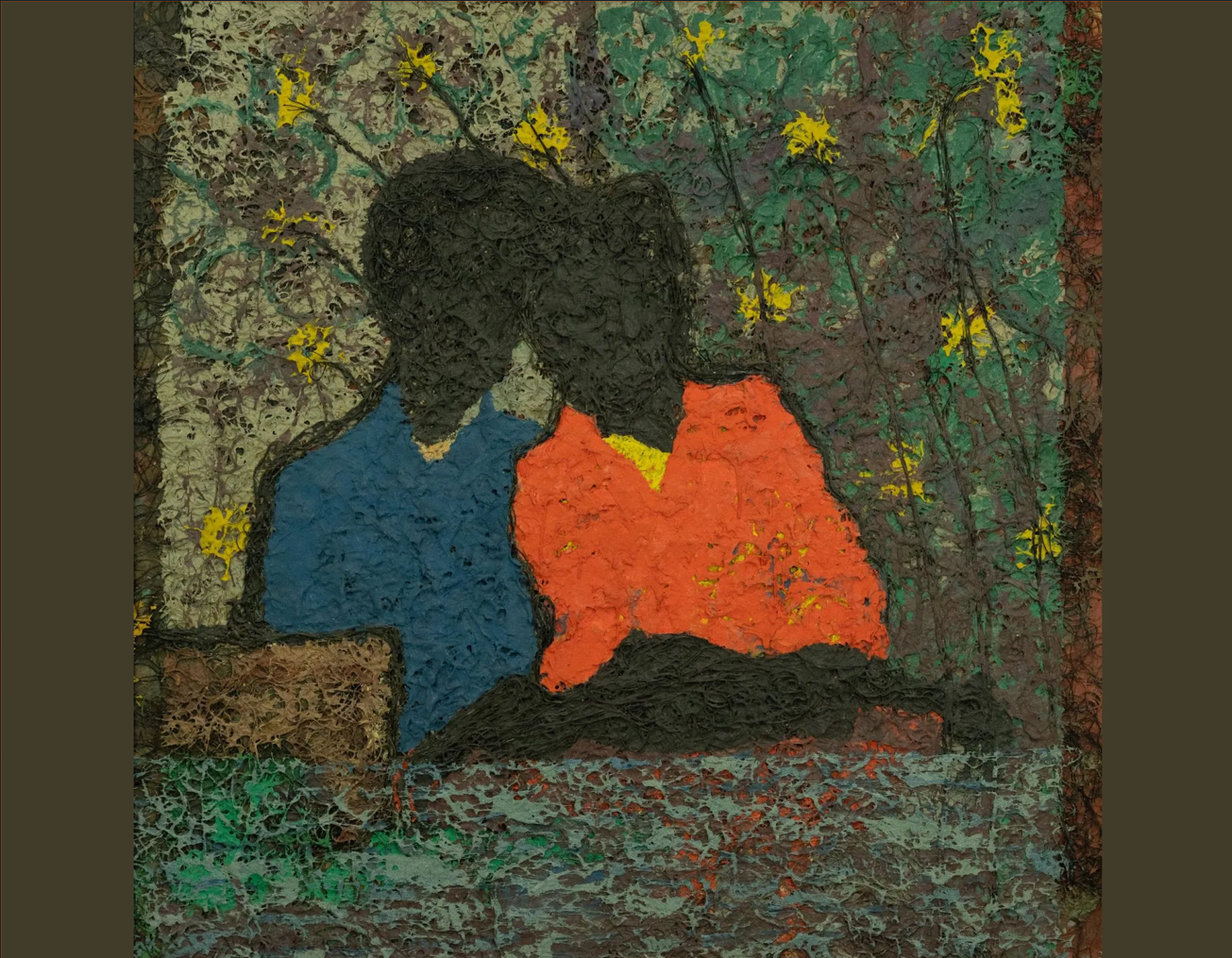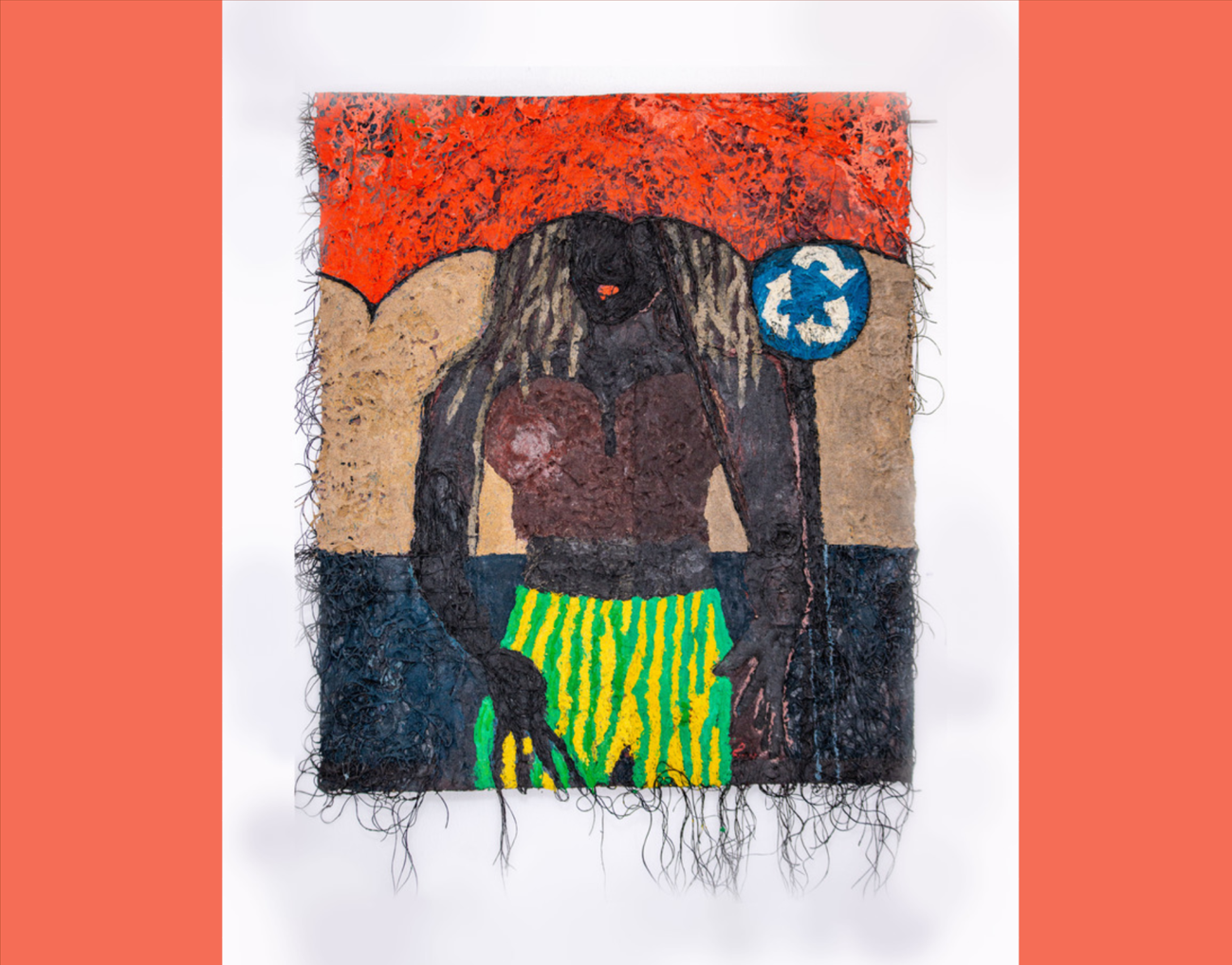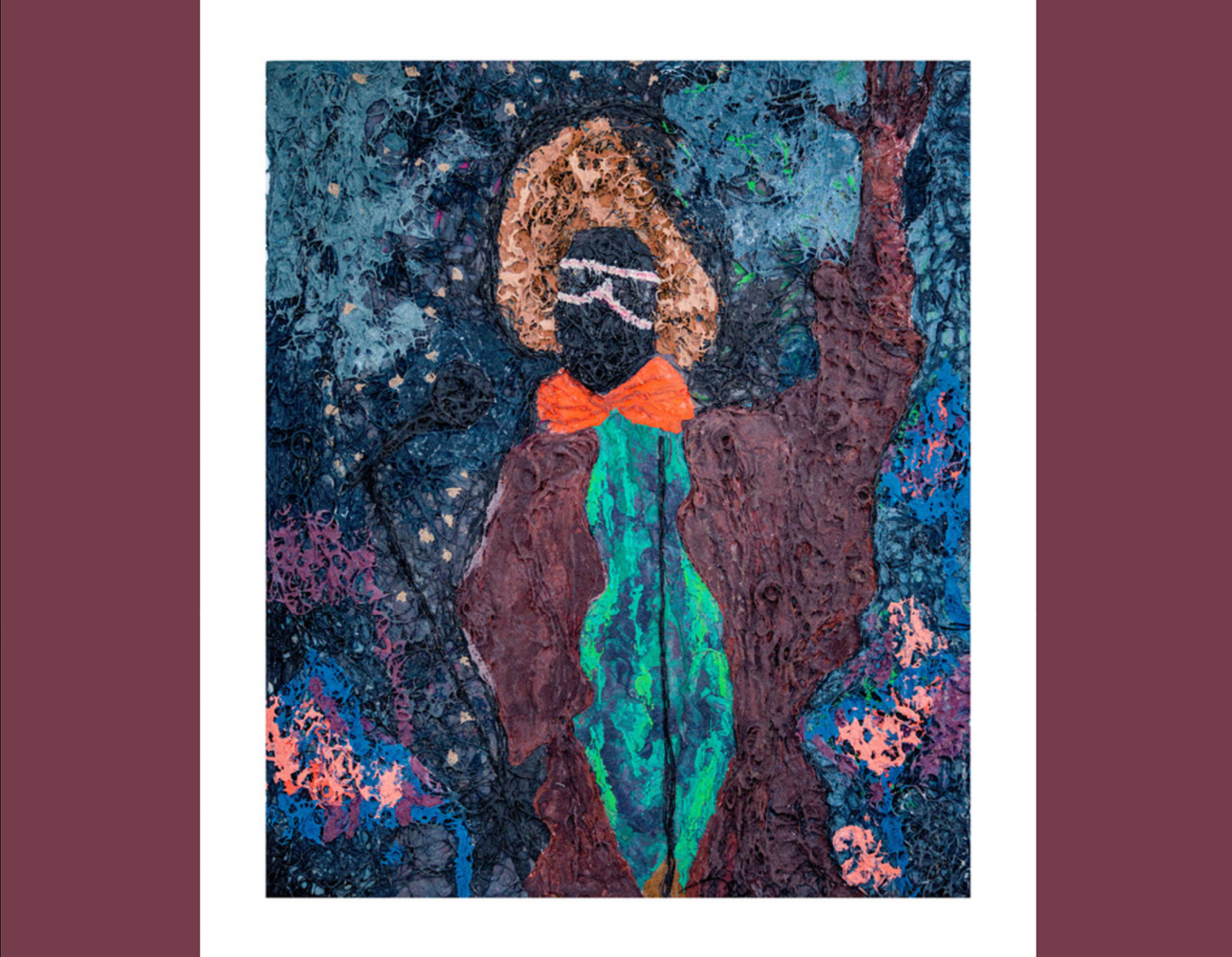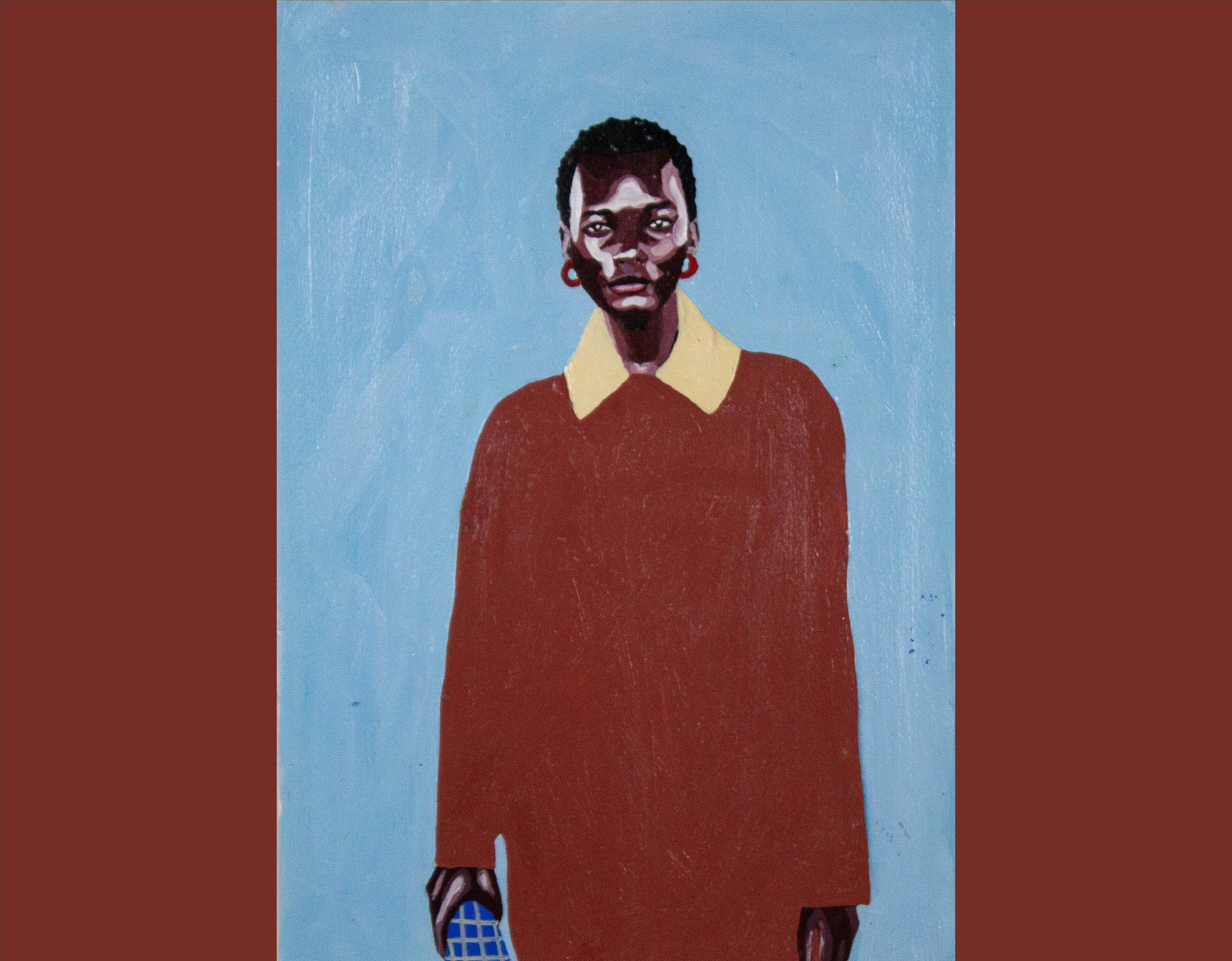An interview with Allen Nabukenya

An interview with Allen Nabukenya
Dominic Muwangudzi
Allen Nabukenya (b.1991) is a Ugandan artist who works with industrial waste to make her colourful, signature artworks. She is also the founder of Njola Impressions, a Ugandan-based sustainable fashion brand that recycles industrial waste materials like car tyres, polythene, plastic bottles and flip-flops into fashion accessories and furniture.
Dominic Muwangudzi speaks with the artist for ARAK.
Why do you create art?
I create art to connect with the ordinary people. I believe art is for everyone just like it is with language. When I create, I am creating for everyone including the person at the lowest level of the community. This is why my art is rooted in the local community.
Is Africa or the African diaspora a part of your vision? If so, what or which Africa?
Yes. This is because my art has a message and I want it to reach as many people as possible. In my art, I am always talking about saving the environment through recycling. This topic cuts across many communities beyond where I live and work because in one way or the other, we are all affected by climate change which is brought about by how we handle waste. Because my message has a global significance my vision is to connect with as many different people as I can beyond Africa and the African diaspora.
Is there anything original in art making? How do you reconcile influence and innovation?
Yes. I will give an example of my practice where I work with tyres. I am not the first artist to recycle this synthetic material because several artists/ artisans before me have worked with it to create sandals and other forms of installations. However, my approach is different because I wanted to break the monotony of creating similar products but also negotiate with the material to create my own identity. As a way to achieve this objective, I decided to marry the tyre material with other materials like flip flops and polythene bags which are colourful to create artworks that are vibrant and impressive. This illustrates how I was inspired to work with tyres by artists before me, but I went further to innovate with other material to create something I believe is original.

Are you self-taught, home-schooled, or shaped by institutional values?
I went to art school and acquired a Bachelors degree in art and industrial design from Kyambogo University. The benefit of doing a degree in art is that it exposed me to different types of art like sculpture, fashion and design, painting and photography. This is why my art is diverse because within my practice I combine fashion, weaving, sculpture and installation.
Does art need society to exist? Is art the inspirational core, a reflection of what society is, or can be?
Yes, art needs society to exist. My art is rooted in the community. Every material I work with is sourced from the community and this makes society part of my art and vice-versa. I am also inspired by society during my creative process. My art is about recycling but why did I end up working with discarded material in my art? I wanted to save the environment, but also I needed to find means of acquiring cheaper but also easily accessible materials for my art because I didn’t have money to afford the expensive material. Secondly, I needed to change the perception that these tyres are used to punish criminals. While growing up, I used to see criminals being burnt to death using tyres. I felt I needed to change that and communicate to the public that these objects can be used to create something beautiful like art. Now many people are using tyres to create productive objects because of what people like me are doing.
Does ‘Contemporary African Art’ mean anything to you?
The way I understand ‘Contemporary African Art’ is the art of now.
What role do you think art institutions play in shaping the discourse around ‘Contemporary African Art’?
These institutions play an important role in revealing to the artists why they create art and why the creative process is equally important just like the final artwork. In my opinion, this is what makes the difference between artists who are self taught and those who have had an opportunity to attend art institutions. The former is probably only interested in creating the final artwork, but the latter is interested in the development of the concept, theme or message in the artwork. Therefore, art institutions’ contribution to the discourse around ‘Contemporary African Art’ in terms of how it is produced cannot be ignored.
Do you see a relationship between art and activism within the context of ‘Contemporary African Art’?
Yes. Art is a language and we artists use it to communicate different things. Through my art, there are people who see me as an environmental activist or social entrepreneur. I am advocating for something which could be a social, political or economic issue.
If I said that African art is a global game-changer, what might this mean to you?
In my opinion, African art and everything indigenous to Africa has always been a global game- changer because we’ve always been looked at for inspiration by the outsiders. Art started here and it was taken outside our continent and later brought back with new definitions, interpretations and approaches. If African art is making headlines in global circles, this is not a new phenomenon.

Race and other identity fixations are commonplace markers in current politics. Is race important? If so, then why? As for other identitarian concerns, how, why, do they matter, if at all?
As an artist, I think race and all those identity fixations as they’re termed, are not important. I believe art is open and why are we artists not open-minded? Why do we want to be part of these conversations that can limit the way we wish to express ourselves?
How do we calibrate provincialism, nationalism, regionalism, continentalism, globalism? Is geopolitics vital in the making of art?
It is difficult to justify these territorial boundaries because they’re things which are imposed on us. Similarly, how we are situated politically and geographically is of least importance in art making. In my opinion, every time these terms are fronted, they only serve one purpose of boxing the creativity of the artist. Like I said earlier, artists are open minded people and should feel the freedom of creating art from anywhere and for everyone.
Is the medium the message? Is a supplementary content important?
Within my practice, the medium is the message because my work is about material and the message or story behind it. From the moment I collect the tyres or flip flops to the final destination of creating an artwork out of it, there’s a reason why I have chosen this particular material to work with. Why do I choose particular colours, textures or negotiate with the material in a certain way? All this is purposeful to me as an artist and this process communicates a message to me. It is part of the larger message I communicate in the final artwork.
What theme(s) or message(s) do you wish to communicate through your work? Why do you think you need an audience and why is it important?
I convey social issues through my work, but when I talk about social issues, I will also be talking about social behaviour which again is related to politics. As such, I may be interrogating or conveying multiple themes within one theme in my work. Why I think an audience is important in my work is because, I see art as a language that should be for everyone. But also, I think it is equally important to think about what type of audiences [you’re speaking to]. When I attend art shows, I see artists talk to fellow artists or people they think can afford their art. In my own view, this is a problem because like I said before, art is for everyone. I would rather have art extended to the commonest person on the streets. For example, I recently had a show in Namuwongo, a city suburb and the residents were excited to see materials they’re familiar with made into art and fashion. Again, this could go back to why an artist makes art because in my situation, I create art to connect with common people.
What role do you think criticism/ art writing plays in the contemporary art market? What does it mean to your own practice?
I value criticism a lot because I believe it is one of the ways artists can improve on what they’re doing. Personally, every time I am criticised, there’s a way my mind is prompted to think differently and further. Unfortunately, we do not have critics who’ve that thick skin to point out the shortfalls in our work.
Cover artwork: Allen Nabukenya, Untitled, 2023. Mixed media, 110 x 110 cm.
This interview has been edited for brevity and clarity.
Only the artwork UNTITLED is in the ARAK Collection.
.svg)


.svg)
.svg)
.jpg)
.png)
